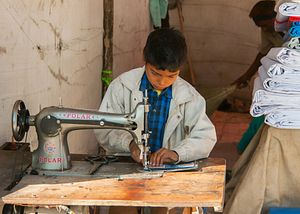The 2014 Global Slavery Report, conducted by the Walk Free Foundation, estimates that India has the highest number of individuals living in slavery out of any country worldwide. The report finds that out of an estimated 35.8 million men, women and children around the world living under conditions of modern slavery, 14 million are in India (followed by 3 million in China and 2 million in Pakistan) . India ranked first in terms of absolute numbers of people in modern slavery, and fifth overall in terms of percentage of its total population (1.14 percent) living in modern slavery (Mauritania, Uzbekistan, Haiti, and Qatar ranked above India, in that order). The total number of slaves in India is 20 percent higher than the 2013 report because of a change in methodology.
Modern slaves are defined as individuals subject to forced labor, debt bondage, human trafficking, forced sexual exploitation, and forced marriage. This is a considerably broader understanding of slavery that addresses issues of human and labor rights beyond the conventional understanding of the term as human property. This is in part why the 2014 report estimates 35.8 million modern slaves worldwide while the International Labor Organization (ILO) counts 21 million worldwide — the ILO estimate focuses on forced labor primarily. According to the Walk Free Foundation, evidence of modern slavery in one form or another was found in all 167 countries surveyed for the 2014 report.
According to the report, India’s case was particularly serious:
India’s modern slavery challenges are immense. Across India’s population of over 1.2 billion people, all forms of modern slavery, including inter-generational bonded labor, trafficking for sexual exploitation, and forced marriage, exist. Evidence suggests that members of lower castes and tribes, religious minorities, and migrant workers are disproportionately affected by modern slavery.
Modern slavery occurs in brick kilns, carpet weaving, embroidery and other textile manufacturing, forced prostitution, agriculture, domestic servitude, mining, and organized begging rings. Bonded labor is particularly prevalent throughout India, with families enslaved for generations.
The report notes that many products manufactured in or exported from India, such as bricks, carpets, cotton, embroidered textiles, garments, rice, and stone, are produced using modern slavery.
The report scores governments on their response to the overall problem of modern slavery within their countries using a proprietary methodology, ranging from AAA for the best government response to D for the worst. The Indian government was given a CCC rating for its response. The report praises the Indian government’s attempts to communicate “key elements of its anti-trafficking response.” The report additionally notes that while practices such as bonded labor are criminalized in India, the enforcement and implementation of key policies and laws is lacking.
Given the continued de facto importance of caste in Indian society, social factors play a role in poor labor and human security outcomes for certain sections of Indian society. The report in particular highlights the vulnerable position of India’s Dalit caste, noting that they have the “least social protections and are highly vulnerable to severe forms of exploitation and modern slavery.” It also notes the relatively poor state of women’s rights in the country, leading to “significant discrimination and high rates of sexual violence” against women and girls in India.
Apart from India, other South Asian states score poorly on the index as well. Pakistan, for example, had a similar percentage of its population living under modern slavery (1.13 percent). Nepal, Bangladesh, and Sri Lanka together add nearly 1 million to the estimated enslaved population of South Asia (ranking 20, 59, and 92 respectively in terms of the percent of their population living under modern slavery). While every government in the broader South Asian region scored at least a C for its response to the issue of modern slavery, Nepal received a B rating. According to the report, in global terms, India, China, Pakistan, Uzbekistan, and Russia are home to 22 million of the world’s modern slaves, accounting for 61 percent of the world total.
































